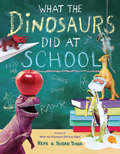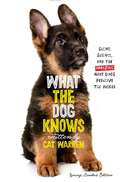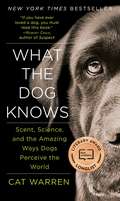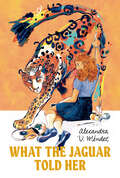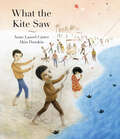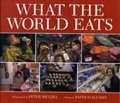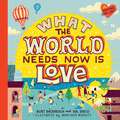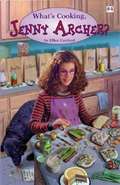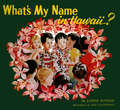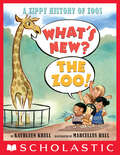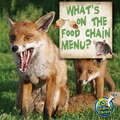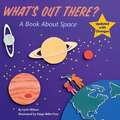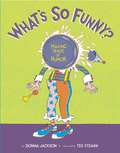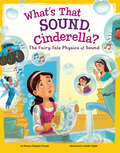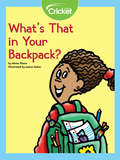- Table View
- List View
What the Dinosaurs Did Last Night
by Refe Tuma Susan TumaFrom the creative parents who brought the world the web sensation "Dinovember" comes photographic proof of what toys get up to when the rest of the house is asleep. You might have noticed weird things happening in your house. Unexplainable messes. Food all over the kitchen floor. Who could the culprits be? Dinosaurs! Boasting bright and hilarious photographs, along with a story written from the point of view of an older, wiser sibling, Refe and Susan Tuma's picture book documents a very messy adventure that shows just what the dinosaurs did last night.
What the Dinosaurs Did at School (What the Dinosaurs Did #2)
by Refe Tuma Susan TumaIn this follow up to the hit What the Dinosaurs Did Last Night, the masterminds behind the social media phenomenon Dinovember once again envision the wonder and chaos of toy dinosaurs come to life-this time in a setting that's perfect for back-to-school! Every November, writer and social media master Refe Tuma and his wife, Susan, work into the night to bring their four children scenes from the secret lives of their toys--specifically the nighttime antics of their plastic dinosaurs. But in the follow-up to the hit What the Dinosaurs Did Last Night, these scampish dinosaurs make the trip to school, hidden in a kid's backpack. Each scene is photographed in meticulous detail, letting viewers joyfully suspend disbelief and think to themselves--just LOOK at what these diminutive dinos did at school!
What the Dog Knows Young Readers Edition: Scent, Science, and the Amazing Ways Dogs Perceive the World
by Cat WarrenIn this young readers edition of the New York Times bestseller, Cat Warren and her canine companion, Solo, teach readers that the nose knows no bounds when it comes to working together, being persistent, and helping others. <P><P>Solo has a fine nose and knows how to use it, but he’s only one of many thousands of scent-detection dogs all over the United States. That’s a group that includes cadaver dogs, tracking, trailing, and apprehension dogs; dogs that can locate unmarked graves of Civil War soldiers; and even dogs that can find drowning victims more than two hundred feet below the surface of a lake. All these dogs love to use their noses. They think their job is simply the best, most interesting game they’ve ever played! <P><P>What good working dogs can do may seem magical or mysterious, but What the Dog Knows shows the science, the rigorous training, and the skilled handling that underlie these amazing abilities.
What the Dog Knows: The Science and Wonder of Working Dogs
by Cat WarrenA firsthand exploration of the extraordinary abilities and surprising, sometimes life-saving talents of “working dogs”—pups who can sniff out drugs, find explosives, even locate the dead—as told through the experiences of a journalist and her intrepid canine companion, which The New York Times calls “a fascinating, deeply reported journey into the…amazing things dogs can do with their noses.”There are thousands of working dogs all over the US and beyond with incredible abilities—they can find missing people, detect drugs and bombs, pinpoint unmarked graves of Civil War soldiers, or even find drowning victims more than two hundred feet below the surface of a lake. These abilities may seem magical or mysterious, but author Cat Warren shows the science, the rigorous training, and the skilled handling that underlie these creatures’ amazing abilities. Cat Warren is a university professor and journalist who had tried everything she could think of to harness her dog Solo’s boundless energy and enthusiasm…until a behavior coach suggested she try training him to be a “working dog.” What started out as a hobby soon became a calling, as Warren was introduced to the hidden universe of dogs who do this essential work and the handlers who train them. Her dog Solo has a fine nose and knows how to use it, but he’s only one of many astounding dogs in a varied field. Warren interviews cognitive psychologists, historians, medical examiners, epidemiologists, and forensic anthropologists, as well as the breeders, trainers, and handlers who work with and rely on these intelligent and adaptable animals daily. Along the way, Warren discovers story after story that prove the capabilities—as well as the very real limits—of working dogs and their human partners. Clear-eyed and unsentimental, Warren explains why our partnership with working dogs is woven into the fabric of society, and why we keep finding new uses for the wonderful noses of our four-legged friends.
What the Jaguar Told Her
by Alexandra V. MéndezJade is starting eighth grade in a new city—Atlanta. She just wants to go back to Chicago, where her friends are. Where her Abuela lives. But Jade does like walking to her new school on the trail that winds through the woods behind her house, where lush flowers bloom and soft leaves rustle beneath her feet. In the forest, Jade feels protected. Sometimes, it's as if it's listening to her. There, Jade meets Itztli, an elderly storyteller who exists between dreams and reality. In the golden afternoons when Itztli appears, he steps out of the forest as a lithe, agile jaguar. But when he speaks to Jade, he is a wise old man who makes intricate works of art and tells her ancestral stories of Mexico. At first, Itztli's stories feel far removed from Jade's life. But as her Abuela suddenly falls ill, two towers come crashing down in New York City, and Jade becomes someone or something she doesn't yet understand, Itztli's stories take on new meaning. Jade must learn to have patience and strength to become who she was always meant to be, as the stirrings of an ancient power awaken within her. What the Jaguar Told Her is a lyrical debut about growing up in the midst of change, and a magical cultural homecoming.
What the Kite Saw
by Anne Laurel CarterIn this memorable story, a young boy finds solace flying his kite from the rooftop after soldiers take his father and brother away. Without his father and brother, the young boy’s life is turned upside down. He and his family have to stay inside, along with everyone else in town. At suppertime, he can’t stop looking at the two empty places at the table and his sister can’t stop crying. The boy looks out the window and is chilled to see a tank’s spotlight searching the park where he plays with his friends. He hears shouts and gunshots and catches sight of someone running in the street — if only they could fly away, he thinks. Each day the curfew is lifted briefly, and the boy goes to the park to see his friends. One day, inspired by the wind in the trees, he has an idea. Back at home he makes a kite, and that night he flies it from his rooftop, imagining what it can see. In this moving story from Anne Laurel Carter, with haunting illustrations by Akin Duzakin, a young boy finds strength through his creativity and imagination. Correlates to the Common Core State Standards in English Language Arts: CCSS.ELA-LITERACY.RL.2.3 Describe how characters in a story respond to major events and challenges.
What the World Eats
by Faith D'Aluisio Peter Menzel<P>Sitting down to a daily family meal has long been a tradition for billions of people. But in every corner of the world this age-old custom is rapidly changing. From increased trade between countries to the expansion of global food corporations like Kraft and Nestle, current events are having a tremendous impact on our eating habits. Chances are your supermarket is stocking a variety of international foods, and American fast food chains like McDonald's and Kentucky Fried Chicken are popping up all over the planet. For the first time in history, more people are overfed than underfed. And while some people still have barely enough to eat, others overeat to the point of illness. <P> To find out how mealtime is changing in real homes, authors Peter Menzel and Faith D'Aluisio visited families around the world to observe and photograph what they eat during the course of one week. They joined parents while they shopped at mega grocery stores and outdoor markets, and participated in a feast where a single goat was shared among many families. They watched moms making dinner in kitchens and over cooking fires, and they sat down to eat with twenty-five families in twenty-one countries--if you're keeping track, that's about 525 meals! <P>The foods dished up ranged from hunted seal and spit-roasted guinea pig to U. N. -rationed grains and gallons of Coca-Cola. As Peter and Faith ate and talked with families, they learned firsthand about food consumption around the world and its corresponding causes and effects. The resulting family portraits offer a fascinating glimpse into the cultural similarities and differences served on dinner plates around the globe. <P>[This text is listed as an example that meets Common Core Standards in English language arts in grades 2-3 at http://www.corestandards.org.]
What the World Needs Now Is Love
by Burt Bacharach Hal DavidFor anyone who needs to be reminded of the power of love, this beautiful book is the perfect gift!With its soothing lyrics and calming tones, "What the World Needs Now Is Love" has become a beloved song worldwide since its release in 1965. Now, for the first time ever, these captivating lyrics are in book form accompanied by gorgeous illustrations, and perfectly packaged with a ribbon enclosure.Both a reminder of the importance of love and a call to make the world a better place, this book is the perfect gift for anyone you care about—or for yourself when you need some gentle comfort.
What to Say Next
by Julie Buxbaum<p>From the New York Times bestselling author of <i>Tell Me Three Things</i> comes a charming and poignant story about two struggling teenagers who find an unexpected connection just when they need it most. For fans of Sophie Kinsella, Jennifer Niven, and Rainbow Rowell. <p>Sometimes a new perspective is all that is needed to make sense of the world. <p>KIT: I don’t know why I decide not to sit with Annie and Violet at lunch. It feels like no one here gets what I’m going through. How could they? I don’t even understand. <p>DAVID: In the 622 days I’ve attended Mapleview High, Kit Lowell is the first person to sit at my lunch table. I mean, I’ve never once sat with someone until now. “So your dad is dead,” I say to Kit, because this is a fact I’ve recently learned about her. <p>When an unlikely friendship is sparked between relatively popular Kit Lowell and socially isolated David Drucker, everyone is surprised, most of all Kit and David. Kit appreciates David’s blunt honesty—in fact, she finds it bizarrely refreshing. David welcomes Kit’s attention and her inquisitive nature. When she asks for his help figuring out the how and why of her dad’s tragic car accident, David is all in. But neither of them can predict what they’ll find. Can their friendship survive the truth?
What's Alive? (Let's-Read-and-Find-Out Science 1)
by Kathleen Weidner ZoehfeldRead and find out about what makes something alive, and what all living things need to stay healthy, in this colorfully illustrated nonfiction picture book.A person and a cat have something in common: You are both alive. People and plants and animals are all alive, but is a doll alive? Or your bike? How can you tell?This is a clear and appealing science book for early elementary age kids, both at home and in the classroom. It's a Level 1 Let's-Read-and-Find-Out, which means the book explores introductory concepts perfect for children in the primary grades. The 100+ titles in this leading nonfiction series are:hands-on and visualacclaimed and trustedgreat for classroomsTop 10 reasons to love LRFOs:Entertain and educate at the same timeHave appealing, child-centered topicsDevelopmentally appropriate for emerging readersFocused; answering questions instead of using survey approachEmploy engaging picture book quality illustrationsUse simple charts and graphics to improve visual literacy skillsFeature hands-on activities to engage young scientistsMeet national science education standardsWritten/illustrated by award-winning authors/illustrators & vetted by an expert in the fieldOver 130 titles in print, meeting a wide range of kids' scientific interestsBooks in this series support the Common Core Learning Standards, Next Generation Science Standards, and the Science, Technology, Engineering, and Math (STEM) standards. Let's-Read-and-Find-Out is the winner of the American Association for the Advancement of Science/Subaru Science Books & Films Prize for Outstanding Science Series.
What's Black and White and Stinks All Over? #4
by Nancy Krulik Aaron BlechaGeorge Brown's super burps are causing serious trouble for poor George again. And this time the trouble really stinks! The super burp strikes on Field Day during an outdoor class scavenger hunt. George vows to keep out of any mischief, but he winds up getting skunked. .
What's Cooking, Jenny Archer?
by Ellen ConfordFollows the comic mishaps of Jenny Archer as she goes into business preparing lunches for friends at school.
What's Eating You?: Parasites--the Inside Story
by Nicola DaviesThe creators of Poop and Extreme Animals return with this in-depth look at how parasites--mites, lice, fleas, ticks, and tapeworms--make their homes on (and in) other creatures, including humans. Full color.
What's Faster Than A Speeding Cheetah?
by Robert E. WellsWhat's faster than a cheetah?--no animal on earth can run faster. But a peregrine falcon can swoop faster than a cheetah can run. And the falcon can't compare to an airplane, a rocket, or the speed of light.
What's Faster Than a Speeding Cheetah?
by Robert E WellsWhat's faster than a cheetah?--no animal on earth can run faster. But a peregrine falcon can swoop faster than a cheetah can run. And the falcon can't compare to an airplane, a rocket, or the speed of light. Lively text and watercolors will make children laugh while they learn all about speed.
What's My Name in Hawaii?
by Ray Lanterman Louise BonnerWhat's My Name in Hawaii? is a multicultural children's story of a little Japanese boy's search for a name.He needs a new one because he is about to become an American citizen in Hawaii, where his parents have come to live from faraway Japan.<P><P>When Toshio Takahashi first goes to school he does not want to play with the other children. Like most beginners, he cries because he misses his mother and mostly because he does not speak or understand English. Language, however, proves no barrier in a child's world and soon Toshio is just another flower in the school called Na Lei o Ka Keiki, "a lei of children".When Toshio's citizenship day approaches, all of his young schoolmates wish to help him select an American name like theirs, to add to those reflecting their various racial backgrounds. Susan Iwalani Au suggests "John" and Lisa Ilima Santiago offers "Gaylord" because she has an uncle by that name.The final choice is a happy one for all most of all, to Toshio whose new name now reveals that he was born in Japan, but is an American citizen living in Hawaii, the 50th State of America.
What's New? The Zoo!: A Zippy History of Zoos
by Kathleen KrullWith friendly facts, funny pictures, and animals galore, What's New? The Zoo! is history to roar for!Did you know . . . * The first zoo was established forty-three hundred years ago in what is now Iraq?* Aztec King Moctezuma II had such an incredible collection of animals that it took six hundred men and women to care for them?* Children across Great Britain wrote to Queen Victoria when Jumbo the elephant was sold away from the London Zoo?* Fifty buffalo passed through Grand Central Station in 1907 on their way to the Bronx Zoo?* Zoos now play a crucial role in animal conservation?Kathleen Krull and Marcellus Hall bring witty insight, jazzy style, and a globe-trotting eye to our millennia-long history of keeping animals -- and the ways animals have changed us in turn.
What's Older Than a Giant Tortoise?
by Robert E WellsIf medals were awarded to animals for living a long time, then a giant tortoise would certainly win one. Some giant tortoises have lived for more than 150 years! Still, there are things on this planet much older than giant tortoises. Some of the giant sequoia trees that grow in California would be more than 3,000 years old. But the trees aren't that old compared to the Barringer Crater in Arizona--that was made about 49,000 years ago. And it's almost impossible to imagine that 65 million years ago, the T. rex dinosaur roamed this planet--but we have the skeletons to prove it!
What's On The Food Chain Menu? (My Science Library)
by Julie LundgrenIntermediate Readers Explore Who's Eating Who And Where.
What's Out There? A Book About Space (Reading Railroad)
by Lynn WilsonWhat is the sun made of? What causes night and day? Why does the moon change shape? An easy-to-understand text bring planets, stars, comets, and the wondrous things out there in space right down to earth in a simple introduction to the solar system for young armchair astronauts.
What's Smaller Than a Pygmy Shrew?
by Robert E WellsA pygmy shrew is among the tiniest of mammals. A ladybug is even smaller. But in this book you will find small things you could not ordinarily see.
What's So Funny?
by Donna JacksonEveryone loves to laugh, and to hear and see funny things-but what makes something funny in the first place? What is humor? This book explains why our brains think something is funny, what happens to us physically when we laugh, why you can tickle your friend but not yourself, and so much more. Plenty of jokes and silly anecdotes are included, and hilarious line drawings appear on almost every page.
What's That Sound, Cinderella?: The Fairy-tale Physics Of Sound (Stem-twisted Fairy Tales Ser.)
by Thomas Kingsley TroupeThe stepsisters yell. The fairy godmother sings. The pineapple-turned-monster-truck burns rubber on its way to the ball. For Cinderella, this evening is an enchanted STEM adventure through the science of sound. For readers, it's a treat of a fractured fairy tale, complete with an ear diagram, a key-term glossary, critical thinking questions, and a sweet pair of glass high-top sneakers.
What's That in Your Backpack?
by Mona PeaseAre you carrying a forest on your back? Of course not! But if you dig through your backpack, you will probably find many things that come from the forest.

